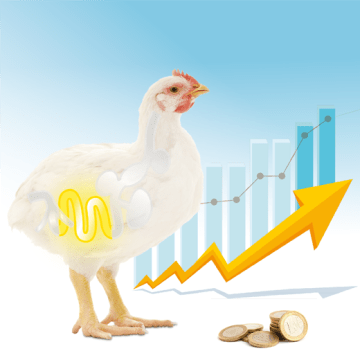 GET THIS NOW: AUTOMATED INCOME MACHINE
GET THIS NOW: AUTOMATED INCOME MACHINE
How to Improve FCR and Reduce Feed Cost of Poultry
Feed conversion ratio (FCR), also known as feed conversion rate is the ratio of inputs to the output. It actually measures the efficiency with which the livestock convert animal feed into the desired output. FCR is widely used in animal husbandry, like poultry farming. Poultry owners raise domesticated birds such as chickens, ducks, geese, and turkeys to produce meat or eggs for food. For poultry farms, for example, the output will be eggs or bird meat.
 Learn More
Learn MoreThe Feed Conversion Ratio is a conducive benchmark that helps determine the profitability of the farm. However, FCR varies depending on the type of production applied. If you wish to increases your revenues, it is essential to improve the Feed Conversion Ratio. With the right Feed Conversion Ratio (FCR), you can explore, monitor, and analyze the data and use it to mitigate risk and take timely actions. Aside from that, it helps you to make the right decisions and have enhanced performance.
FCR for different types of breeds.
The bird’s ability to convert nutrients is an essential aspect of overall performance efficiency in the poultry business. Here are FCR for different types of breed:
Purchase this compelling ebook instantly. 
 33 fundamentals for poultry layer production management
33 fundamentals for poultry layer production management
A broiler sold at 2.5 kg with a live-weight FCR of 1.9:1 simply means it ate 4.75 kg of feed to reach that end weight.
However, assuming a weight yield of 75% at slaughter and 10% of carcass weight that is represented by bones, with a cooking loss of 20%, the 2.5 kg live broiler would be 1.35 kg of edible meat. In this case, the FCR into edible meat would be 3.52:1.
While a laying hen that produces 5 kg of eggs would eat 11 kg of feed. And the FCR, in this case, would be 2.2:1. Let’s assume an egg weighs 60 grams with 55 grams edible contents, the FCR for this would be 2.4:1. While with a loss of 2%, the FCR value for the edible content would now become 2.45:1.
Likewise, a red label chicken of slow-growing strain reared outdoors and slaughtered at 12 weeks will have an average FCR ranging between 2.8 to 3.2
Ways to Improve FCR and Reduce Feed Cost
FCR determines how well a flock converts feed intake. With the increasing feed prices, it becomes imperative to have ways to control feed wastage, reduced feed cost, and improved FCR. Here are some ways to have improved FCR and reduced feed cost:
1. KEEP EFFICIENT BREEDS
First things first, keeping breeds that require less feed will automatically reduce feed cost. Usually, dual-purpose breeds consume more feed than laying breeds. If you don’t intend to sell bird meat, then keeping a more feed efficient breed such as Aseel, frizzle fowl, etc.
READ ALSO What to do When Your Poultry Birds are Sneezing
2. TRY MIXING WHOLE GRAINS WITH CHICKEN FEED
Mixing whole grains with chicken feed will not only help you have reduced cost but also it will provide more nutrition to your flock.

3. FERMENT CHICKEN FEED
Another best way to reduce feed cost is – fermenting chicken feed. All you have to do is soak grains, seeds, or legumes a night before in chemical-free water and cover it up. Fermented feed is suitable for poultry, it contains all the bacteria that’s good for their gut. It boosts their intestinal health and also increases egg weight, shell weight, and shell thickness.
4. RAISE ACTIVE FORAGERS
You can consider raising active foragers. These birds often find their own feed when provided with good-sized pasture or allowed to free-range. Active foragers are a great way to have improved FCR value and reduced feed cost.
READ ALSO 10 important things to monitor to guarantee success in poultry farming
5. FEED THEM WITH TABLE SCRAPES
You don’t need to throw table scraps or cracked eggs; instead, you can utilize the same to feed your chicken. All you have to do is – toss all table scraps, eggshells, cracked eggs, and garden waste and feed your chicken.
Invest in this knowledge-packed ebook promptly.  39 fundamentals for poultry broiler production management
39 fundamentals for poultry broiler production management
6. GROW YOUR OWN FEED
If you have enough space where you can grow your own feeds, then better utilize that. You can grow anything from sunflower seeds to field peas to feed your chicken.
ATTENTION: Click “HERE” to join our WhatsApp group and receive More updates directly on your WhatsApp!
7. LET YOUR BIRDS FREE-RANGE
Free-ranging can also help you have reduced feed cost, as your birds will be able to feed themselves. However, you should have enough space for your birds to free-range. You can safely free-range your chicken during the day they will feed on whatever they like, such as seeds, grass, bugs, and weeds. Believe it or not, variation in their diet will keep them healthy, happy, and well-fed.
8. DON’T OVERFEED YOUR FLOCK
Overfeeding your flock will not only add to your feed cost but also it will spoil your birds. Yes, too many treats will eventually increase the cost of keeping a flock. Apart from this, overfed chickens develop fatty tissue in their abdomens, thereby leading to decreased egg production. So, don’t overfeed them.















